The Museum Collections
Introduction
I. History and Art Collection
1. Icons of the 14th – 19th centuries
icons of the 14th – 17th century
2. Jewelry art of the 14th – 20th century
jewelry art of the 14th – 17th century
jewelry art of the 18th – 19th century
the european silver 14th - 19th centuries
3. Small-size sculptures (works of metal, wood, bone)
XI – the beginning of the XX century
Small-size sculptures 11th – 17th century
Small-size sculptures 18th – early 20th century
enamel of Troitza masters 15-8th – early 20th century
5.Embroidery, lace, textiles of the 14th - early 20th century
icon and ornamental embroidery
gold and silver lace
6.Painting of the 18th – 21st centuries
painting of the 18th – 19th centuris
painting of the 20th – 21st centuris
II.Manuscripts and old printed books of the 14th – 17th century
IV.Lithography of the 18th – 19th century
V.Numismatics
VI.Medals of the 18th - early 20th century
VIII.Archeology collection
IX. Russian folk and applied and decorative art of the 17th – 21st c.
1. Artistic wood
folk carved and painted wood
wooden toys
house carving of Sergiev Posad
Khokhloma and Gorodets painting
2. Artistic textiles
embroidery and weaving
printed textiles and lace
Russian shawls
folk costumes
folk garments
printed cotton kerchiefs
|
Jewelry Art of the 14th – 17th cc. (page 3)
|
Chasing occupied a significant place in adornments of items made of precious metals. Its soft shining reliefs decorate book covers, icon mountings, all kinds of secular and church articles. The craftsmen preferred floral patterns. The ornaments are rhythmic, graphic and distinct. The mounting for the icon “St. Sergius of Radonezh”, made to the order of Tsar Feodor Ivanovich, is an outstanding work of the 16th century Moscow chasers. It was used as a cover for the shrine of Sergius.
There were skilful craftsmen in the Monastery too. They made a number of attractive items at the late 16th – early 17th century. The spherical chandeliers were commissioned by Cellarer Eustathius Golovkin and Marfa Vladimirovna Staritskaya. They were completely covered with a chased floral pattern and decorated with a sculptural dove. To some extent, the chandelier of 1568, presented by Ivan the Terrible, could be used as a model for them. The beautiful gospel cover was commissioned by the Monastery Cellarer Eustathius Golovkin in 1602.
|
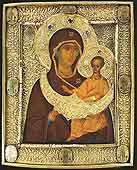
Icon. The Virgin Hodigitria.
16th century |
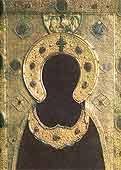
Mounting for the icon “St. Sergius of Radonezh”.
1585. Detail |
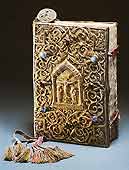
Gospel. 1602.
Donated by Eustathius Golovkin
|
The works of the late 16th – early 17th century jewelry art are magnificent and luxurious, like the mounting of the main Monastery icon “The Trinity of Old Testament”, made to the order of Boris Godunov in 1599 – 1600. In the subsequent centuries the mounting was supplemented. In 1626, Tsar Mikhail Feodorovich presented the crescent collars, made by German craftsmen Hast Jakub and Lenta Johan who used the crescent collars of Ivan the Terrible as a model. In the mid-18th century the gilded silver chasuble, blocking the icon, was made.
At the time of Boris Godunov engraving and niello was widely used together with chasing. The works of the Moscow Kremlin workshops were most decorative. Boris Feodorovich Godunov donated the Pearl icon-cloth, air “The Holy Trinity”, mitre, chalice of 1597, candlestick of 1599, gold plates, mounting for “The Trinity of Old Testament” painted by Andrei Rublev, decorated with nielloed plaques. Niello of the late 16th – early 17th century is very refined. The intricate engraved and nielloed floral pattern covers nearly the whole surface of the elegant chalice of 1597, presented by Boris Godunov, when he was a tsar stable boyar of Tsar Feodor Ivanovich.
|
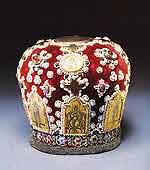
Mitre. Late 16th – early 17th century. Donated by Tsar Boris Godunov |
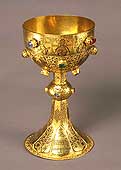
Chalice. 1597. Donated by Boyar Boris Feodorovich Godunov |
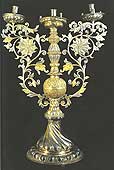
Candlestick. 1599. Donated by Tsar Boris Feodorovich Godunov |
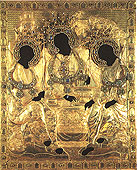
Mounting for the icon “The Old Testament Trinity”, painted by Andrei Rublev. 16th - 18th centuries
|
The collection of the 17th century jewelry art is rich and varied. The mitre, donated to the Monastery in memory of Prince Feodor Ivanovich Mstislavsky by his wife and daughter. The main center of jewelry art was the Armory Chamber of the Moscow Kremlin. The gold- and silversmiths of the Armory Chamber developed the techniques of their predecessors. They made a lot of items to be donated to the Trinity-St. Sergius Monastery.
The silversmith Ivan Leontiev was commissioned by the Duma Deacon Ivan Tarasyevich Gramotin to produce gold liturgical vessels – chalice, discos and two plates. The fine nielloed miniatures decorate the gold lid of the large silver cross-reliquary donated to the Monastery in memory of I.T. Gramotin. The miniatures are in perfect harmony with the cross decoration – delicate pearls on gold holders on the lid edges are combined with emeralds, rubies and a sapphire fixed on the low end of the cross. The gold cross, made by Andrei Malov, is marked by an exceptional beauty. It is decorated with chased gold plaques with nielloed images, multi-colored stones and pearls.
|
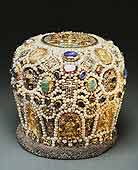
Mitre. 1626. Donated in memory of Prince Feodor Ivanovich Mstislavsky |
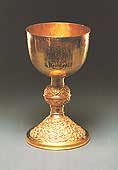
Chalice. First half of the 17th century. Work of Ivan Leontiev. Donated in memory of the Duma Deacon Ivan Tarasyevich Gramotin |
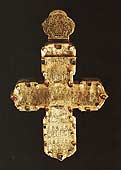
Cross-reliquary. First half of the 17th century. Donated in memory of the Duma Deacon Ivan Tarasyevich Gramotin |
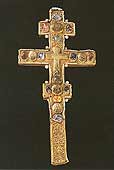
Cross-reliquary. 17th century. Work of Andrei Malov
|
|


